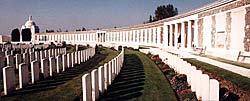|
|
Details taken from www.cwgc.org
Commonwealth War Graves Commission Casuality Details Name: Osborne, Frank Compton Initals: F C Nationality: United Kingdom Rank: Private Regiment: Machine Gun Corps (Infantry). Formerly 26697, Oxfordshire and Buckinghamshire Light Infantry. Unit Text: 97th Company, Machine Gun Corps (Infantry). Age: 26 Date of Death: 02/12/1917 Killed in action. No known grave. Service No: 81720 Additional Information: Born and resident Castlethorpe, enlisted Bletchley. Son of Thomas and Annie Elizabeth Osborne, of Castlethorpe, Stony Stratford, Bucks. Casualty Type: Commonwealth War Dead Grave/Memorial Reference: Panel 154 to 159 and 163A. Cemetery: Tyne Cot Memorial Zonnebeke, West-Vlaanderen
Tyne Cot Memorial, The Tyne Cot Memorial is one of four memorials to the missing in Belgian Flanders which cover the area known as the Ypres Salient. Broadly speaking, the Salient stretched from Langemarck in the north to the northern edge in Ploegsteert Wood in the south, but it varied in area and shape throughout the war. The Salient was formed during the First Battle of Ypres in October and November 1914, when a small British Expeditionary Force succeeded in securing the town before the onset of winter, pushing the German forces back to the Passchendaele Ridge. The Second Battle of Ypres began in April 1915 when the Germans released poison gas into the Allied lines north of Ypres. This was the first time gas had been used by either side and the violence of the attack forced an Allied withdrawal and a shortening of the line of defence. There was little more significant activity on this front until 1917, when in the Third Battle of Ypres an offensive was mounted by Commonwealth forces to divert German attention from a weakened French front further south. The initial attempt in June to dislodge the Germans from the Messines Ridge was a complete success, but the main assault north-eastward, which began at the end of July, quickly became a dogged struggle against determined opposition and the rapidly deteriorating weather. The campaign finally came to a close in November with the capture of Passchendaele. The German offensive of March 1918 met with some initial success, but was eventually checked and repulsed in a combined effort by the Allies in September. The battles of the Ypres Salient claimed many lives on both sides and it quickly became clear that the commemoration of members of the Commonwealth forces with no known grave would have to be divided between several different sites. The site of the Menin Gate was chosen because of the hundreds of thousands of men who passed through it on their way to the battlefields. It commemorates those of all Commonwealth nations except New Zealand who died in the Salient, in the case of United Kingdom casualties before 16 August 1917. Those United Kingdom and New Zealand servicemen who died after that date are named on the memorial at Tyne Cot, a site which marks the furthest point reached by Commonwealth forces in Belgium until nearly the end of the war. Other New Zealand casualties are commemorated on memorials at Buttes New British Cemetery and Messines Ridge British Cemetery. The TYNE COT MEMORIAL now bears the names of almost 35,000 officers and men whose graves are not known. The memorial, designed by Sir Herbert Baker with sculpture by Joseph Armitage and F V Blundstone, was unveiled by Sir Gilbert Dyett in July 1927. The memorial forms the north-eastern boundary of TYNE COT CEMETERY, which was established around a captured German blockhouse or pill-box used as an advanced dressing station. The original battlefield cemetery of 343 graves was greatly enlarged after the Armistice when remains were brought in from the battlefields of Passchendaele and Langemarck, and from a few small burial grounds. It is now the largest Commonwealth war cemetery in the world in terms of burials. At the suggestion of King George V, who visited the cemetery in 1922, the Cross of Sacrifice was placed on the original large pill-box. There are three other pill-boxes in the cemetery. There are now 11,952 Commonwealth servicemen of the First World War buried or commemorated in Tyne Cot Cemetery. 8,365 of the burials are unidentified but there are special memorials to more than 80 casualties known or believed to be buried among them. Other special memorials commemorate 20 casualties whose graves were destroyed by shell fire. The cemetery was designed by Sir Herbert Baker. |
